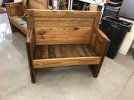I don't use the stuff so I couldn't say. It's like 25% solvents and the rest mineral oil with a bit of stain in it. I'm guessing that it works like this, at least on NC lacquers... for water/steam ring the solvents act like blush eliminator and soften the lacquer enough allow the trapped water to evaporate. Maybe it also softens the lacquer just enough to let minor scratches get buffed out. The mineral oil cuts the strength of the solvents so you don't end up wiping off the lacquer. For deeper scratches that go to the wood, the mineral oil and stain soak in a bit, offering a better color match to the finished wood than the bare exposed wood does. At least that what it appears like on photos on Amazon reviews. For curing varnishes, I doubt it would do much, but most 20-70 year-old commercially-made furniture is finished with NC. Just speculating as to the mechanism, but that makes sense to me.
I don't think that the idea is that you finish on top of it. I think the idea is that you put it onto your furniture that you don't want to refinish, If it doesn't work, you strip the piece or throw it away.



